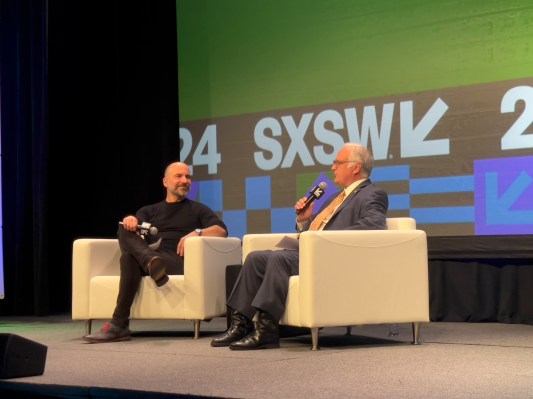Uber’s future will be greener, more affordable, and able to challenge Amazon at its own rapid delivery game, CEO Dara Khosrowshahi predicted while onstage this week at SXSW.
His vision, which he charted out during an interview with city of Austin mayor Kirk Watson, isn’t entirely new. The company made a commitment in 2020 that all of its trips in the United States and Europe would be zero emissions by the end of the decade. To achieve that, Uber has to make it easier and cheaper for drivers to access electric vehicles. And Uber has long talked about making its app so “sticky” that consumers turn to it regularly for rides and delivery.
These goals seem a bit more attainable — and higher on the priority list — now that Uber has finally ticked the profitability box. In 2023, the company posted its full-year profit as a public company. And Khosrowshahi appears keen to accelerate.
The sustainability target, which he described as the company’s single most important long-term initiative, is at the top of that list.
While “sustainability” is a favorite term for corporations to bandy about, Uber has set targets and earmarked $800 million to help drivers use electric vehicles. For instance, Uber has partnered with automakers Tesla, Kia and GM, as well as rental companies Hertz, Avis and Ford to offer discounts on affordable EVs. The company has launched in-app features to reduce charging anxiety and partnered with startup Revel to give drivers charging discounts up to 25% off and access to up to 250 charging stations. Uber has also partnered with BP Pulse and EVgo to offer charging discounts and invested 5 million pounds to build out charging infrastructure in three London boroughs.
The efforts have moved the needle. The company said that as of last year, there were more than 126,000 monthly active zero-emission vehicle drivers using the app. Drivers have completed 287 million fully electric trips over the last three years, according to Uber. The largest percentage, at 20%, were in London.
Uber, in conjunction with Khosrowshahi’s SXSW appearance, announced a new emission savings feature that allows riders to track and understand their estimated carbon emissions impact. Uber said emissions are calculated based on Uber Green and Uber Comfort Electric rides, and the amount of CO2 emissions avoided compared to UberX or Uber Comfort trips of the same distance.
Riders can go to their account section of the Uber app to access the “estimated CO2 saved” feature, which shows all the emissions saved by taking Uber Green and Uber Comfort electric rides.
Uber said this week it is launching Uber Green and Uber Comfort Electric for teen riders in more than 15 cities, including New York City, Chicago, Philadelphia, Austin, and Seattle.
Affordability
Khosrowshahi also said affordability is a big deal for Uber.
“At this point, Uber is … a middle-class type or upper-class type of product, and we have got to get Uber to be more affordable for consumers,” he said, adding that can be achieved by changing the “form factor,” such as using electric scooters and getting people to share rides.
“It takes a lot to convince someone to share a vehicle with another person,” he said.
Much of the shared-ride progress has been made outside of the United States. He said UberX shared and high-capacity vehicles that can carry 14 to 22 people (essentially an Uber bus) and run in a lot of developing countries are “an important part of our path going forward.”
“There’s a certain percentage of consumers who are willing to give up a little bit of convenience in a ride with someone else in the car in order to save some money and we really have to push that because we want to get Uber to be more affordable to many, many more people around the world,” he added.
Out-Amazoning Amazon
Khosrowshahi’s greatest ambitions may be for Uber Eats, which has helped drive the company’s revenue and is one of the fastest growing parts of the business.
“The future there is about not just delivering food to your home, but delivering anything to your home,” he said. “We essentially want to build out a local logistics on-demand infrastructure that’s available for people to take place-to-place, for people to send packages to each other, and for businesses to be able to out-Amazon Amazon,” he said. “We want the local business to be able to get a package over to you not next day, but actually same day.”
Uber started with restaurants and then expanded to grocery store chains and liquor stores. Eventually, Khosrowshahi wants every local merchant in a customer’s town to use Uber for delivery.
Autonomy will be a part of that future, he said.
“Autonomous will be a big part of that, but first we’ve got to get the sustainability target; second we’ve got to get [to] shared; third, we have to have access to everybody no matter where you live,” he said, adding they want access to local merchants as well. “And then eventually we’ll get to an autonomous vehicle.”
Uber no longer develops autonomous vehicle technology; that ended when it sold off Uber ATG to Aurora in 2020. Under the terms of that deal, Uber handed over its equity in ATG and invested $400 million into Aurora, which gave it a 26% stake in the combined company. Since then Uber has partnered with autonomous sidewalk delivery startups Cartken and Serve Robotics and robotaxi companies Waymo and Motional.
